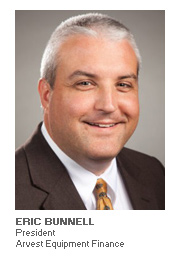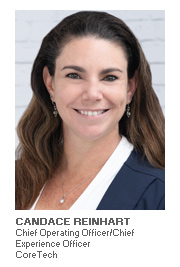
The Equipment Leasing & Finance Foundation (Foundation) released its Q3 update to the 2023 Equipment Leasing & Finance U.S. Economic Outlook in mid-July. According to this report, high interest rates and slowing economic growth will continue to impact equipment and software investment growth as the year progresses. The Q3 update also indicated economic growth in Q1 was stronger than initially estimated, which led the Foundation to raise its annual U.S. GDP forecast to 1.6 percent. However, as a result of investment contracting in the first quarter coupled with a possible recession still on the horizon, the Foundation revised its annual estimate for equipment and software investment growth down slightly, from 1 percent to 0.9 percent.
Equipment Finance Advisor met with three industry leaders representing a cross-section of the equipment finance industry to gather their thoughts on this latest report and the trajectory for the equipment finance industry in 2023 from their unique perspectives. Our participants included Eric Bunnell, President of Arvest Equipment Finance (Bank-owned), Candace Reinhart, Chief Operating Officer and Chief Experience Officer of CoreTech (Independent), and Christopher Johnson, President, Financial Services of Pitney Bowes (Captive).
To kick off our discussion, we asked our participants to describe their view of the current economic environment, and if they agree with the Foundation and various economists that the U.S. economy will likely experience a recession in 2023.

“I agree with the Foundation’s updated forecast,” said Eric Bunnell. “We are witnessing customers slowly adapt to the higher interest rates, but many are taking their time and assessing if the equipment purchase is necessary at this time or if they can postpone the purchase. If it is essential to their everyday business, they are moving forward with purchases, but in other cases they might choose to make their current equipment last longer.”
Candace Reinhart said, “The current economic environment is a complex interplay of forces. The stronger than initially estimated economic growth in Q1, propelled by consumer spending and government expenditure, offered promising signs. This resilience, coupled with an unexpectedly robust labor market, prompted the Foundation to revise the annual U.S. GDP forecast upward to 1.6%. That said, headwinds, including a contraction in investment, still suggest caution. The potential element of tightening lending standards and the anticipation of a credit crunch as the Foundation noted pose challenges that we need to keep our eyes on, particularly as we aim to give an ongoing best possible product to the borrowing market.”

“We are navigating through a much more complex macro-economic environment that has several cross currents which are hard to forecast,” said Christopher Johnson. “Let’s start with the high-level summary. It’s my belief that we are certainly seeing economic corrections in a number of segments of the economy. There are several factors to watch including demand (durable goods versus services), supply levels (both excess and areas of limitation), price, labor (including participation rates and demographics), consumer spending and buying power, money costs / interest rates, and corporate earnings.” Johnson continued saying, “Across these metrics there are several competing points. For instance, over the past several quarters services demand has been strong while manufacturing / goods has weakened. However, manufacturing has started to snap back with pricing power being exerted by large manufacturers, which has helped drive earnings to beat estimates in the segment. As another example, labor costs have remained elevated across the economy, which continues to fuel consumer spending along with corporate investment in technology and automation as companies work to position their businesses to operate inside of the context of a new labor market that will persist for the foreseeable future. Overall, while it will take time, I believe that the economy will slow as consumers and businesses grapple with higher costs (whether inflation, pricing or interest rate related) and take measures to address declining operating cash flow. I foresee this happening somewhere in the tail end of the second quarter to early third quarter of 2024.”
Equipment Finance Demand
We asked our participants to describe their view of equipment financing demand in Q2 2023 and if new business volume exceeded their expectations from early in the year or had fallen short. We also asked which sectors stood out for their companies as winners or laggards.

“The equipment financing sector continues to be an integral cog in the economic machine, across all industries,” said Reinhart. She continued saying, “Despite broader economic uncertainties and a slight tempering in growth, we note that the volume of new business is holding steady, particularly for flexible lenders with a deep understanding of their borrowers' key requirements. In Q2 2023, the resilience of equipment financing demand is evident. Although the industry noted a minor dip in new business volume between April and May due to rising interest rates and stricter lending standards, we believe the overall year-on-year growth remains positive. This signals a market that is adjusting and evolving to the new economic climate. These challenges notwithstanding, opportunity remains for those lenders adept at navigating these shifts, reinforcing the economic benefits of commercial equipment finance, and meeting the specific needs of borrowers.”
Johnson said, “Financing demand continued to be in line with our forecast and consistent with the trends we saw in the first quarter. Investments in essential assets continue to be strong and are performing well, especially in the context of the last two years. Within Pitney Bowes Financial Services, we have seen this trend across all sectors we serve, whether large, mid-market, small business or municipal sector clients.”
“We had a steady Q2 as far as volume goes. Even though we have seen a significant increase in rates this year, there is still demand for equipment financing,” said Bunnell. “We have seen inventory levels improve so some of this demand could be from 2022 when inventory levels were lower. The transportation industry remains volatile and, in my opinion, lagging behind other industries.”
Stress in the Market
The U.S. economy has been stronger than anticipated driven by a strong labor market and resilient U.S. consumers. However, inflation remains above the Federal Reserve’s target, and many believe a looming credit crunch is on the horizon. With this as the backdrop, we asked our participants if their organizations are experiencing any stress among their customers.
“We have a very large portfolio of clients, over 650,000 customers, and as a result see a microcosm of the economy,” said Johnson. He continued saying, “As you would expect, we pay very close attention to credit related trends and are seeing a tightening cycle develop across the financing markets. With this said, ironically, we are seeing the best portfolio performance in over 15 years. Customer payment trends are healthy, delinquency is down, and non-performing assets have declined year over year. This is in part due to the focus we have on critical use assets, the hard work we have put in over the last several years to be ready for market change, and a large focus we have on data insights and analytics, which has meaningfully strengthened the way we work and how we proactively approach risk management at Pitney Bowes Financial Services."
Bunnell said, “We have kept asset quality top of mind in 2023 and began reviewing our credit parameters last year in preparation for a downturn in the economy. We have seen some customers in the transportation industry seek payment relief or modifications. I think overall underwriting has tightened.”
According to Reinhart, structuring sound transactions is required today saying, “Amid potential economic turbulence, the importance of well-structured financing solutions is heightened. It is of paramount importance to understand our clients' circumstances, the hurdles they face and to offer innovative solutions tailored to their individual needs. By adopting this approach, we effectively manage potential stressors and assure our clients that they are supported and secure. Despite inflation exceeding the Fed's target and concerns over a looming credit crunch, our organization has not observed an uptick in delinquency. This stability can largely be credited to our diligent approach to client relationships and a thorough understanding of our clients' business models. Our role extends beyond being mere financiers—we see ourselves as strategic partners, collaborating closely with our clients to navigate any economic challenges.”
Lending Standards
According to the report, lending standards for commercial and industrial (“C&I”) loans have tightened at nearly half of banks. We asked our participants if they believe banks will continue to tighten lending standards as the year progresses, and if there will be any benefits to equipment finance companies as a result of this tightening.
“Asset quality will need to continue to be monitored closely and make adjustments when necessary,” according to Bunnell. “Banks are also keeping a close eye on liquidity and need to make sure the deal makes sense not only from a credit perspective but also from a profitability perspective as cost of funds continue to increase.”
“In light of the current economic scenario and rising concerns over a potential recession, banks are likely to persist in tightening lending standards throughout the year, said Reinhart. “This defensive stance, taken in response to economic volatility, may indeed pose challenges for captives and bank-owned leasing companies, given their strong ties to traditional banking frameworks. However, this climate enables independent equipment finance providers to demonstrate their agility and adaptability. Unrestricted by the inflexibility of traditional banking, independents can effectively maneuver through changing economic environments, offering clients bespoke financing solutions that cater to their specific needs. As we navigate these shifting conditions, the transition in lending standards provides an opportunity to showcase the benefits of an independent's adaptable approach. This period underscores our ability to offer stability, swift responses, and innovative solutions when our clients need them most, and indeed, highlights the inherent strength of independent equipment finance providers in supporting clients through economic uncertainties.”
“Being both a captive and a non-captive financier, as well as a bank and a non-bank financier, it is important for us to be consistent as it relates to how we are approaching risk,” said Johnson. He continued saying, “We have made changes over time to our risk models and remain committed to updating these based on the data we see emerge from actual underlying portfolio performance. One benefit that we have beyond the sheer size of our customer base, is that the average relationship with our clients is over 15 years so we have quite a bit of knowledge of our customers that spans different economic cycles (both up and down) from which we can leverage. Internally we have not taken or made dramatic steps / changes to our models this year but will remain vigilant and will refine our approach as we navigate a slower & lower growth economy. Lastly, I do expect many Bank and Independent leasing companies to pull back from the market and prudently reassess their exposure while the market settles out. This won’t be across the entire market, but it is my belief that there will be less liquidity available for lower middle-market and small business companies.”
As a wrapped up to our discussion, we asked if and how our participants and their companies utilize the Foundation’s Economic Outlook.
“Absolutely, the Foundation's Economic Outlook serves as a vital resource for our company. It not only informs our understanding of the evolving economic landscape, but also provides critical insights that we share with our clients," said Reinhart. “It helps us decipher growth opportunities and stressors in the industry, thereby guiding strategic decisions and assisting our clients to navigate their market environments. The Economic Outlook therefore has a significant role in shaping our business strategy and facilitating meaningful dialogue with our clientele.”
Bunnell echoed this response saying, “As one of the largest equipment finance banks in the U.S., we find the Foundation reports to provide very valuable information and always look forward to reviewing them. We especially use it to monitor how different industries and market segments are performing. Our sales teams then can adjust their calling and marketing efforts and focus on those industries that are performing better. I also use this information to keep our board of directors updated.”
“The Foundation does an excellent job with its Economic Outlook. We tend to look at it annually as a part of our strategic refresh process, according to Johnson. “From time to time, we will compare revisions in the Outlook with what we are seeing from other sources and internally from our portfolio.”
We thank our participants for their time and invaluable insights!
Readers may access the Q3 Report here.
Readers may also download the Momentum Monitor here.